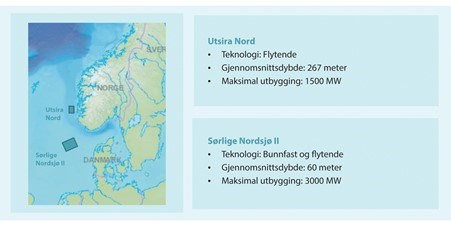Important step for Offshore Wind
Press release | Date: 06/12/2022 | Ministry of Energy
The Norwegian Government has great ambitions for the development of offshore wind power in Norway and aims to tender the first phase of Sørlige Nordsjø II and Utsira Nord by the end of the first quarter of 2023.

The Government wants a close dialogue with the offshore wind industry and other users of the sea when the tender documents are to be drawn up, and wants input on, among other things, pre-qualification, auction model and support scheme.
— Today is an important day for offshore wind! We aim to allocate areas suitable for 30,000 MW offshore wind by 2040, and hereby present the framework for allocating the areas in Utsira Nord and the first phase of Sørlige Nordsjø II. Collaboration is a key to success, and I hope we get a lot of input in the public consultation we have just published. This will set the standard for offshore wind in Norway, says Minister of Petroleum and Energy Terje Aasland (Labour party).
In the package sent for public consultation, the Government's proposal for pre-qualification criteria, qualitative criteria and the allocation, auction and support model is presented. In the public consultation, there is also an overview of the division of the areas in Sørlige Nordsjø II and Utsira Nord.
— The Government wants investments in offshore wind to provide industrial development in Norway, facilitate innovation and technology development, and provide increased production of renewable power in Norway. To achieve these goals, we must have a close dialogue with the offshore wind industry and other users of the sea, says Aasland.
Read the consultation documents (in Norwegian)
- Høring av prekvalifiseringskriterier og auksjonsmodell for Sørlige Nordsjø II
- Høring av kvalitative kriterier og støtteordning for Utsira Nord
The deadline for making consultation comments is 6th of January 2023.
Background information
Sørlige Nordsjø II
In the consultation memorandum, the Government presents its proposal for pre-qualification criteria, auction model and a possible support model. In addition, information is provided on other matters relating to Sørlige Nordsjø II.
A pre-qualification will be carried out for actors who wish to compete for the area in Sørlige Nordsjø II, first phase. The Ministry of Petroleum and Energy has drawn up a proposal for pre-qualification criteria that will contribute to the development of offshore wind in Norway in a sustainable way, and to ripple effects for society.
There will be an upper limit for the number of applicants who can be pre-qualified to participate in the further competition. In the public consultation, we ask for input on how this upper limit should be set. Applicants who are pre-qualified will then have the opportunity to participate in an auction.
If there is need for state funding, the Ministry's proposal is that this be done through a two-sided contracts for difference. Any state funding will be limited by an upper ceiling.
When the Government has chosen the auction model, the main consideration has been that there should be an efficient distribution of society's resources, i.e. with the lowest possible level of state funding. The proposed auction model is a so-called Anglo-Dutch auction.
Utsira Nord
The areas of Utsira Nord will be awarded on the basis of qualitative criteria. Among other things, the criteria will facilitate innovation and technology development in floating offshore wind.
Utsira Nord has been opened for a capacity of 1,500 MW. The government will divide this area into three areas, where a wind power plant of 500 MW can be built within each area. Also for Utsira Nord, the general goal is that state funding is as low as possible, in the the process for allocating areas. Thus, there will be a competition for state funding.
